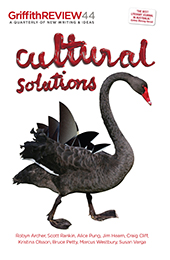ALICE SPRINGS, THE modern town at the centre of the Australian continent, is also a converging point of ancient Aboriginal songlines and for thousands of years the homeland of Arrernte-speaking clans. Today Aboriginal people, with Arrernte in the majority, make up one fifth of the town’s population. Their presence, however, has mostly not been reflected in the construction of the town’s public spaces in ways other than negative. A 1981 mural by Bob and Kaye Kessing, on the new Coles supermarket, projected an image of inter-cultural harmony long before the word ‘reconciliation’ was on anybody’s lips. At this time the outpouring of art by Aboriginal peoples of the desert had been underway for a decade. Alice Springs became a hub for the movement, and this was reflected in the commissioning of a number of significant works of public art – at the Araluen Arts Centre and airport – but not in the town centre. After strong lobbying, lead by artist Pip McManus, in 2006 the Town Council finally adopted a public art policy. As its first manifestation in 2009 Council commissioned The Gathering Garden for a prominent position in the Civic Centre grounds. This work, a collaboration of ten Central Australian Aboriginal artists with a Melbourne-based sculptor, stands at the head of a recent conscientious, if somewhat haphazard, striving towards balance in the cultural order of the public space.
TODD MALL, FOR more than two decades a pedestrian street running the length of two town blocks, is Alice Springs’ premier gathering place. If there’s a festival, a market, a protest march, it’s likely to happen there, rivalled only by the adjacent Civic Centre lawns. The mall is home to the town’s most attractive cafés, to art galleries, including the renowned Aboriginal-owned Papunya Tula Artists, to fashion and gift shops, to Adelaide House, the region’s first hospital and most handsome historic building, and to the John Flynn Uniting Church. These last two are set in grassed and treed grounds, which the church has generously left unfenced, open for community use. At night, though, the mall is largely a deserted, shuttered place, the frequent scene of antisocial and at times criminal behaviour, which the expensive installation of CCTV surveillance has done little to curb. In recent years its property values have stagnated, a number of businesses, including a pub, have closed and premises have remained vacant for lengthy periods, in some cases years.

Already a subscriber? Sign in here
If you are an educator or student wishing to access content for study purposes please contact us at griffithreview@griffith.edu.au





